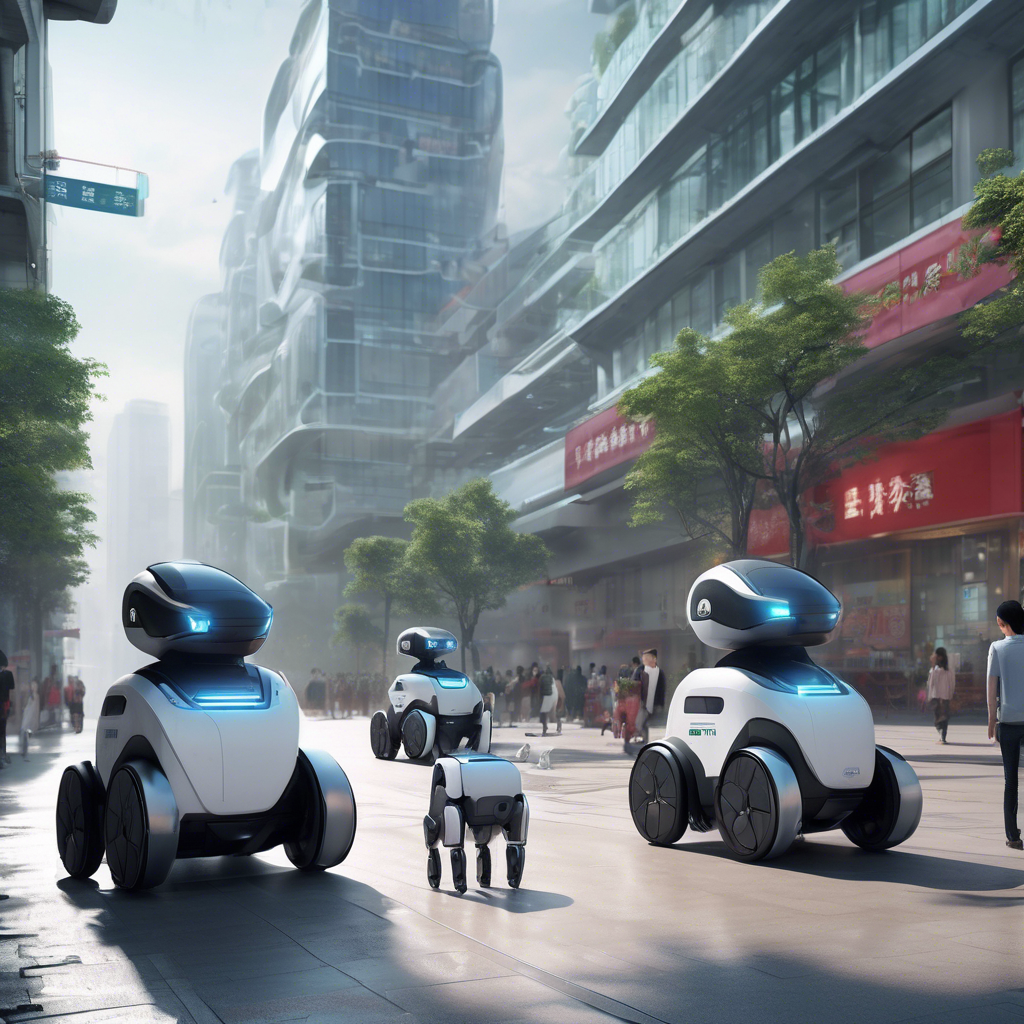China's AI and Robotics Revolution: Drones, Humanoids, and Industry Growth

On a misty Saturday afternoon in Shenzhen’s Central Park, teenage girls gather under a concrete canopy, singing Mandopop ballads and sharing snacks. Their laughter is interrupted by a buzzing sound signaling an order's arrival. Nearby stands an “airdrop cabinet, ” one of over 40 operated by Meituan, China’s largest food delivery platform, where park visitors can order everything from rice noodles to bubble tea. A drone, loaded from a nearby mall, arrives and deposits the goods into a locked box opened by the customer’s phone number—delivering dinner without human involvement. Meituan aims to be 10% faster than human couriers, though the food, including char siu pork and a waffle, arrives slightly cold after its aerial journey. These delivery drones exemplify a fraction of China’s broader robotics and AI industry, which Beijing is eager to expand amid challenges like the US-China trade war, demographic shifts, and deteriorating relations with the US. Chinese leaders view AI as key to enhancing military power, addressing workforce declines, and bolstering national pride, especially as firms navigate around US sanctions on core technologies. Technology companies, once suppressed by President Xi Jinping to curb excessive private influence, are now encouraged again to spur domestic innovation and restore confidence in the private sector. In March, Premier Li Qiang pledged to “unleash the creativity of the digital economy, ” particularly emphasizing “embodied AI. ” Guangdong province, home to Shenzhen—the country’s drone capital—leads this push, having allocated 60 million yuan (£6. 4 million) in funding to innovation centers. Shenzhen benefits from progressive drone regulations fostering the “low altitude economy, ” with China’s Civil Aviation Administration forecasting a fivefold industry growth to 3. 5 trillion yuan within ten years. Beyond drones, humanoid robots are gaining attention. At this year’s Spring Festival gala, viewed nearly 17 billion times, dancing humanoid robots from Unitree were a highlight. Recently, the world’s first humanoid vs. human half marathon occurred near Beijing. According to Rui Ma, a tech analyst and investor, AI’s application to robotics accelerated dramatically last year, potentially driving faster industry growth in 2025. Reinforcement learning allows robots to learn from experience in months rather than years, speeding innovation. Robot dogs are already common in China; in Yiwu’s wholesale market, a child plays with one while his mother negotiates prices. In Shanghai, robot dogs walk alongside owners, carrying shopping baskets. Robotics development is tightly linked to AI advances, with China striving to catch up to the US. President Xi aims to fuel growth through “new quality productive forces, ” including advanced technologies. Washington worries its tech lead is shrinking. Controlling semiconductor supply is a major US strategy to limit China’s access to advanced AI chips, described by former national security adviser Jake Sullivan as a “high fence” protecting strategic technology. But in January, a Chinese firm, DeepSeek, stunned the tech world by releasing R1, a large language reasoning model matching leading US competitors at a fraction of the cost. This triggered a Wall Street tech index crash, wiping out $1 trillion in value amid fears the US’s tech dominance was threatened. Rui Ma called it “a crazy moment” fueling optimism in China’s AI sector.
The government had already promoted AI as key to long-term growth, and public confidence surged following DeepSeek’s breakthrough. Li Shuhao, a Guangzhou-based AI entrepreneur, recalls that after DeepSeek’s success, arranging meetings with US AI scientists became much easier. Li describes DeepSeek’s founder Liang Wenfeng’s approach—self-funding through a hedge fund rather than venture capital—as emblematic of Chinese entrepreneurs’ survival-first mentality. DeepSeek’s open-source publishing aligns with government preferences, encouraging widespread adoption, especially benefiting robotics. China’s robotics supply chain breaks down into three areas: the brain (AI), the body (hardware), and real-world application. China excels at hardware and application, shown by capabilities in EVs and drones, but developing AI “brains” that enable human-like robot behavior remains challenging. DeepSeek’s R1 model helps domestic robotics firms narrow the gap with foreign competitors, especially since it runs on less advanced chips, leveling competition. Challenges remain: AI models require vast training data. While large language models benefit from abundant internet content, robotic models demand scarce data describing physical movement and interaction. For instance, autonomous vehicles must operate within six axes of freedom—forward/back, left/right, up/down, plus rotations. Humanoid robots performing everyday tasks need up to 60 degrees of freedom; Unitree’s H1 robot possesses 27. Robots don’t need full human form to be useful. Wheeled or limited-motion robots can automate hazardous or repetitive tasks, such as factory work. Shenzhen’s UBTech provides humanoid robots to car factories, helping offset China’s shrinking labor force. At last month’s Boao Forum for Asia, a robot arm made traditional jianbing pancakes (though less crispy than human-made). In Beijing, autonomous buggies equipped with cameras enhance park surveillance. Yet, widespread replacement of workers by robots remains limited. Amber Zhang, a Beijing data intelligence product manager, notes that many logistical hurdles persist. Baidu runs autonomous “robotaxi” fleets in a few cities, but services can be slow and limited. For example, in Shenzhen, attempts to hail a robotaxi failed or involved long waits, while human drivers arrived quickly. Similarly, state media’s predicted “robocops” remain invisible. Still, the narrative is shifting. Facing economic headwinds from tariffs, weak consumer demand, and a cooling real estate sector, the Chinese government is eager to support promising industries like AI and robotics. Local governments, no longer reliant on real estate revenues, strive to attract and back innovative companies. Tech’s role in growth “is clicking for people, ” says Rui Ma, as viable investment opportunities narrow. This marks a dramatic change from just a few years ago, when tech companies were sidelined amidst Xi’s crackdown on private-sector wealth and influence—the halted 2020 Ant Group IPO and Alibaba founder Jack Ma’s fall demonstrating this shift. Recently, Jack Ma met with Xi alongside other tech leaders like DeepSeek’s Liang, signaling tech entrepreneurs’ restored favor. Li Shuhao says such engagements “give us confidence” that tough times are over. Additional research by Jason Tzu Kuan Lu.
Brief news summary
On a misty Saturday in Shenzhen’s Central Park, teenage girls watch a Meituan drone delivering food, symbolizing China’s rapid advances in robotics and AI. Despite challenges like trade tensions, demographic shifts, and strained US relations, Beijing prioritizes AI development to bolster its military, address labor shortages, and inspire national pride. Shenzhen stands at the forefront of innovation with technologies such as drones and humanoid robots. Companies like DeepSeek challenge US tech dominance by providing affordable, open-source AI models, including the R1 language model. Chinese robots integrate complex supply chains with AI “robot brains” to execute advanced tasks, though fully replicating natural human movement remains difficult. Practical applications include autonomous taxis and robotic food delivery, with robots mainly handling repetitive or hazardous jobs as full automation evolves. The tech sector’s revival benefits from renewed entrepreneurial support under Xi Jinping, following earlier regulatory restrictions. Facing pressures on traditional industries, China views AI and robotics as vital for economic growth and achieving global technological leadership.
AI-powered Lead Generation in Social Media
and Search Engines
Let AI take control and automatically generate leads for you!

I'm your Content Manager, ready to handle your first test assignment
Learn how AI can help your business.
Let’s talk!

AI Overviews: Google's AI-Generated Summaries in …
Google has launched an innovative feature called AI Overviews within its search engine to improve how users access online information.

Pakistan Forms New ‘Crypto Council’ to Regulate B…
Pakistan has made a significant move to embrace and regulate the emerging digital economy by establishing the Pakistan Crypto Council (PCC).

With Quantum Entanglement And Blockchain, We Can …
No offense to Einstein, but he was certainly wrong about quantum theory—it has not only endured but also proven invaluable across computing, biology, optics, and even games of chance.

Meta's $14.8 Billion Investment in Scale AI Raise…
Meta, formerly Facebook, has invested $14.8 billion in Scale AI, a startup specializing in data-labeling services.

U.S. House Approves Blockchain Development Bill
On Wednesday, the U.S. House of Representatives made a notable advance by voting 279-136 to approve the Financial Innovation and Technology for the 21st Century Act (FIT21).

Google Plans to Sever Ties with Scale AI Amid Met…
Google plans to end its relationship with Scale AI, a leading data-labeling startup, following Meta’s recent acquisition of a 49% stake in the company.

Circle’s Native USDC Goes Live on World’s Blockch…
On Wednesday, June 11, the company announced that Circle’s USDC and the upgraded Cross-Chain Transfer Protocol (CCTP V2) had officially launched on World Chain.

 Auto-Filling SEO Website as a Gift
Auto-Filling SEO Website as a Gift








 Auto-Filling SEO Website as a Gift
Auto-Filling SEO Website as a Gift

